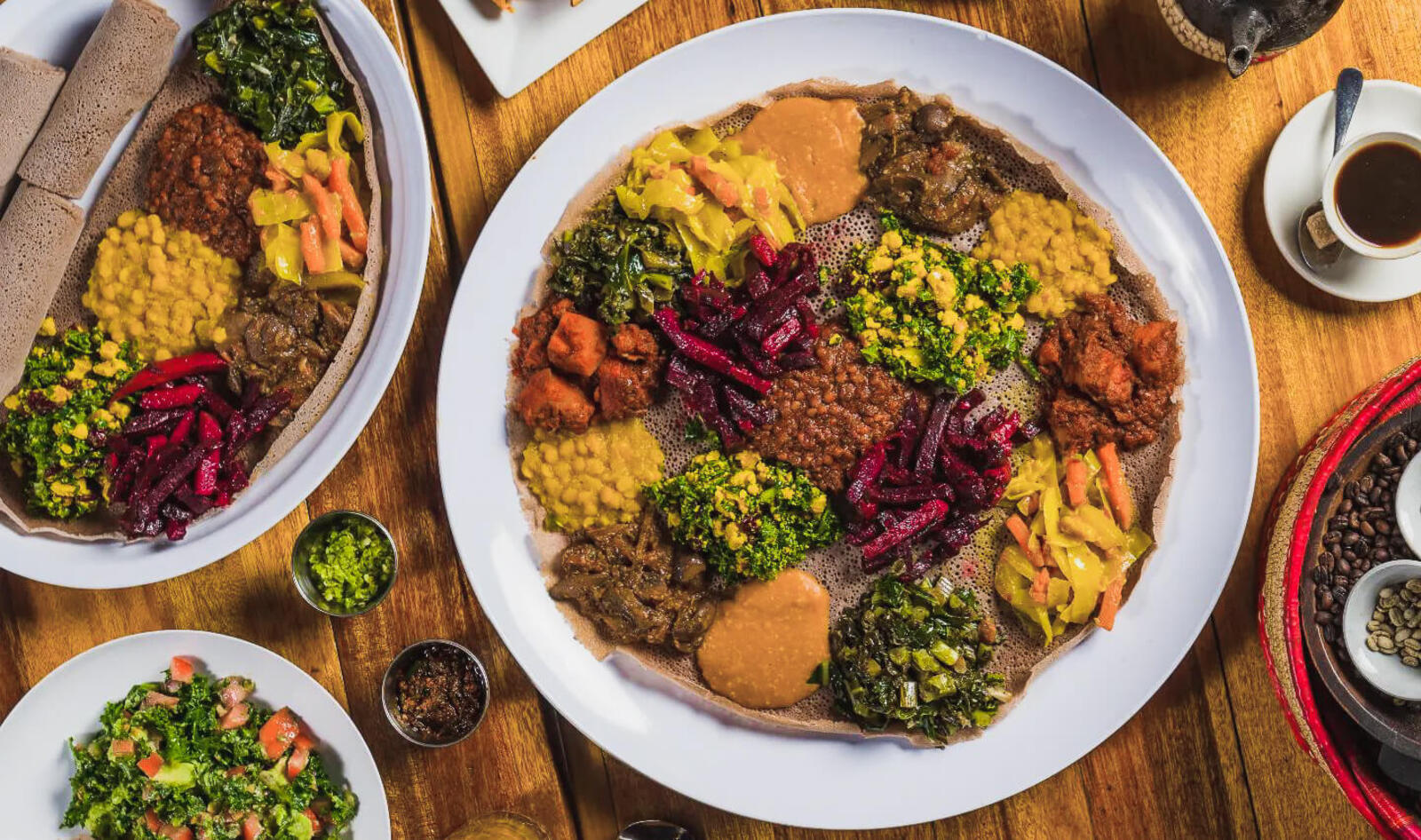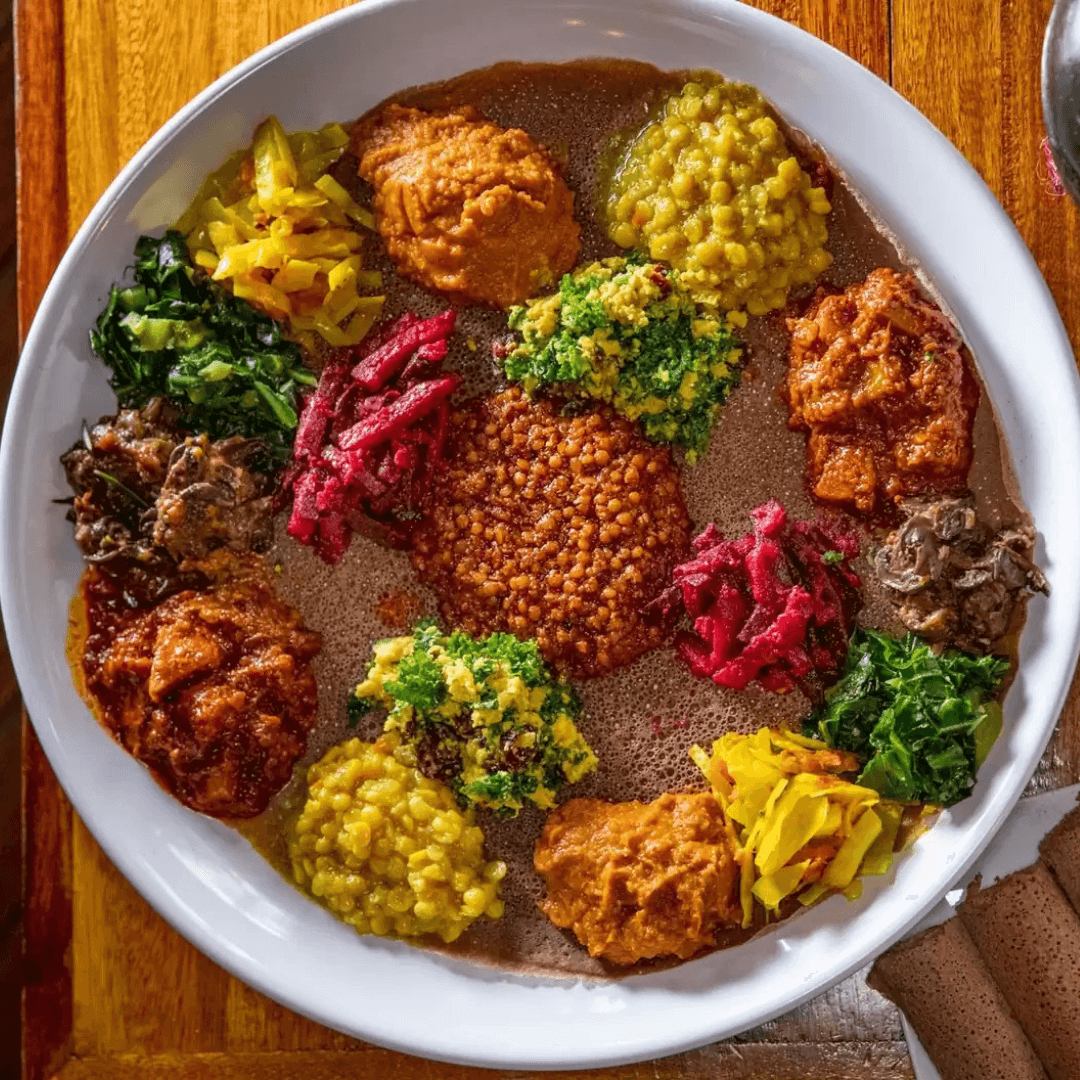Embark on a culinary adventure with vegan Ethiopian food, a vibrant cuisine that tantalizes taste buds and celebrates the rich cultural heritage of Ethiopia. From its humble origins to its significance in Ethiopian festivals, vegan Ethiopian cuisine offers a delectable tapestry of flavors and textures.
This ancient cuisine, deeply rooted in plant-based ingredients, showcases a symphony of spices, herbs, and cooking techniques that create dishes that are both nourishing and soul-satisfying. Join us as we delve into the captivating world of vegan Ethiopian food, exploring its history, key ingredients, and the cultural significance that makes it a beloved culinary treasure.
Key Ingredients and Dishes

Vegan Ethiopian cuisine is a vibrant and flavorful culinary tradition that utilizes a unique blend of spices, legumes, and vegetables.
Key ingredients include:
- Berbere:A fiery spice blend made from chili peppers, garlic, ginger, and other spices.
- Teff:A gluten-free grain used to make injera, the spongy flatbread that serves as the base for many dishes.
- Legumes:Lentils, chickpeas, and beans are commonly used as protein sources.
- Vegetables:Collard greens, spinach, and carrots are popular additions to vegan Ethiopian dishes.
- Niter Kibbeh:Clarified butter infused with spices, adding a rich flavor to dishes.
Popular Vegan Ethiopian Dishes, Vegan ethiopian food
Some popular vegan Ethiopian dishes include:
- Shiro:A chickpea stew seasoned with berbere and served with injera.
- Misir Wot:A lentil stew flavored with berbere and onions.
- Gomen:Collard greens cooked with garlic, ginger, and onions.
- Tikil Gomen:Cabbage and carrots cooked in a spicy berbere sauce.
- Injera:The spongy flatbread made from teff flour, serving as a base for many dishes.
Nutritional Value
Vegan Ethiopian food is rich in fiber, protein, and essential vitamins and minerals.
- Fiber:Injera and legumes provide ample dietary fiber, promoting digestive health.
- Protein:Lentils, chickpeas, and beans are excellent sources of plant-based protein.
- Iron:Collard greens and other leafy vegetables are rich in iron, supporting red blood cell production.
- Calcium:Teff flour contains calcium, essential for bone health.
Cooking Methods and Techniques
Vegan Ethiopian cuisine relies on traditional cooking methods that have been passed down through generations. These methods showcase the unique flavors and textures of Ethiopian cuisine while preserving the nutritional value of the ingredients.The most common cooking methods include:
- Injera baking:Injera is a sourdough flatbread that serves as the staple accompaniment to most Ethiopian dishes. It is made from teff flour and fermented for several days before being cooked on a hot griddle called a mitad.
- Stewing:Stewing is a slow-cooking method that allows flavors to meld and develop. Many Ethiopian stews are made with a base of berbere, a spicy spice blend, and include vegetables, legumes, and occasionally meat.
- Roasting:Roasting is a popular method for cooking vegetables, such as potatoes, carrots, and peppers. Vegetables are often roasted with a blend of spices and herbs, resulting in a flavorful and caramelized exterior.
Use of Spices and Herbs
Spices and herbs play a vital role in vegan Ethiopian cooking, adding depth and complexity to the dishes. The most commonly used spices include:
- Berbere:A blend of chili peppers, fenugreek, ginger, garlic, and other spices, berbere is the backbone of many Ethiopian dishes.
- Mitmita:A spicy blend of chili peppers, cumin, and cardamom, mitmita is often used as a finishing spice.
- Korarima:A blend of rosemary, thyme, and oregano, korarima adds a herbaceous flavor to dishes.
Fresh herbs are also widely used, including cilantro, parsley, and basil. These herbs add freshness and brightness to the dishes, complementing the rich flavors of the spices.
Cultural and Social Aspects

Vegan Ethiopian food holds a significant place in Ethiopian culture, deeply intertwined with religious traditions, social customs, and communal celebrations.
Ethiopian Orthodox Christianity, widely practiced in the country, observes several fasting periods throughout the year, during which adherents abstain from animal products. Vegan Ethiopian dishes, rich in plant-based ingredients and spices, play a crucial role in sustaining individuals during these periods.
Social and Communal Aspects
Ethiopian dining is inherently social and communal, with meals often shared among family, friends, and neighbors. Vegan Ethiopian dishes facilitate this communal dining experience, as they can be easily prepared in large quantities and shared among a group.
The act of breaking bread together, known as “injera sharing,” is a symbol of unity and hospitality in Ethiopian culture. Vegan injera, made from fermented teff flour, serves as a versatile base for various vegan dishes, further emphasizing the social and communal aspects of Ethiopian dining.
Importance in Festivals and Celebrations
Vegan Ethiopian food holds a special place in Ethiopian festivals and celebrations. During religious holidays such as Meskel and Timkat, traditional vegan dishes like doro wat (a spicy lentil stew) and injera are prepared and shared among the community.
These dishes not only provide sustenance but also serve as symbols of unity and shared cultural heritage. The preparation and consumption of vegan Ethiopian food during festivals and celebrations strengthen communal bonds and reinforce the importance of tradition.
Health Benefits

Vegan Ethiopian food offers numerous health benefits due to its abundance of plant-based ingredients, rich in vitamins, minerals, antioxidants, and fiber. Studies have shown that consuming a vegan Ethiopian diet can improve overall health, reduce the risk of chronic diseases, and promote longevity.
Research suggests that vegan Ethiopian food is particularly beneficial for heart health. The high fiber content helps lower cholesterol levels, while the antioxidants protect against oxidative stress and inflammation. Additionally, the plant-based proteins and healthy fats contribute to satiety, reducing the risk of overeating and obesity.
Potential Health Risks
While vegan Ethiopian food is generally healthy, there are potential health risks to consider. One concern is the low intake of certain nutrients, such as vitamin B12, iron, and calcium. These nutrients are primarily found in animal products, so vegans need to ensure they obtain them from fortified foods or supplements.
Another potential risk is the high intake of carbohydrates in some vegan Ethiopian dishes. While carbohydrates provide energy, excessive consumption can lead to weight gain and blood sugar imbalances. To mitigate this risk, it is important to balance carbohydrate intake with adequate protein and fiber.
Tips for Making Vegan Ethiopian Food Healthier
Here are some tips for making vegan Ethiopian food healthier:
- Use whole grains instead of refined grains for increased fiber and nutrient content.
- Incorporate a variety of vegetables and legumes into dishes to ensure a wide range of vitamins, minerals, and antioxidants.
- Choose lean protein sources, such as lentils, beans, and tofu, to reduce saturated fat intake.
- Limit the use of processed foods and sugary drinks, which can contribute to unhealthy weight gain.
- Cook with healthy oils, such as olive oil or avocado oil, instead of unhealthy fats.
Conclusion: Vegan Ethiopian Food
In conclusion, vegan Ethiopian cuisine is a testament to the country’s rich culinary heritage and cultural diversity. Its vibrant flavors, wholesome ingredients, and unique cooking techniques offer a tantalizing culinary experience that caters to a wide range of dietary preferences.
Beyond its culinary appeal, vegan Ethiopian food holds a significant place in Ethiopian culture. It embodies the country’s commitment to plant-based diets and its deep respect for tradition. By embracing vegan Ethiopian cuisine, we not only enjoy delicious and nutritious meals but also connect with the cultural fabric of this vibrant nation.
Call to Action
We encourage all food enthusiasts to explore the delights of vegan Ethiopian cuisine. Whether you are a seasoned vegan, a curious omnivore, or simply seeking a culinary adventure, vegan Ethiopian food offers a unique and unforgettable gastronomic journey. Immerse yourself in its rich flavors, embrace its cultural significance, and discover the joy of plant-based dining at its finest.
Commonly Asked Questions
What are the key ingredients used in vegan Ethiopian dishes?
Vegan Ethiopian dishes rely on a vibrant array of plant-based ingredients, including lentils, chickpeas, split peas, vegetables, and spices such as berbere, turmeric, and fenugreek.
Is vegan Ethiopian food healthy?
Yes, vegan Ethiopian food is generally considered healthy as it is rich in fiber, protein, and essential nutrients. It is also low in saturated fat and cholesterol.
Can I make vegan Ethiopian food at home?
Absolutely! With the right ingredients and a bit of practice, you can recreate the authentic flavors of vegan Ethiopian dishes in the comfort of your own kitchen.
